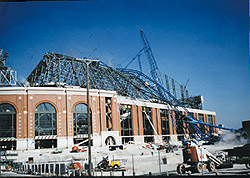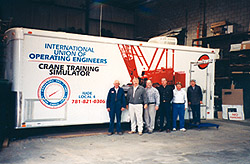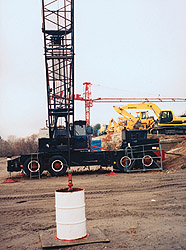When crane picks go awry, they can do so with catastrophic consequences to life, limb and property. These periodic punctuations to the need for greater safety are stimulating a nationwide appetite for more operator training, certification and licensing, and new technology in simulators is reducing risk in early stages of training.
 |
| WINDY Miller park probe and litigation focused on wind gusts during lift of roof truss. (Photo courtesy of John A. Tharen) |
Partially in response to some serious accidents, the International Union of Operating Engineers started developing its own certification program in the mid-1990s. But in 1997, it threw its support behind a crane operator certification program called the National Commission for the Certification of Crane Operators.
"It's not just a union program," says Stephen A. Brown, the union's director of construction training. "NCCCO wanted it to be a national program so it has a mixed board of directors, including open-shop representatives." The program now is operating in 45 states and has tested and certified more than 14,000 operators.
Fairfax, Va.-based NCCCO is an industry-sponsored organization that got its impetus more than 10 years ago after a series of fatal crane accidents prompted rental firms and contractors, among others, to start a dialogue on safe crane operation. "We started testing in 1996," says Graham J. Brent, executive director.
In 1999, the U.S. Occupational Safety and Health Administration recognized NCCCO certification. "I believe that's the first time we've done that," says H. Berrien Zettler, deputy director of OSHA's Directorate of Construction. "There are many schools that train crane operators but NCCCO is different because it is not a training school and it meets strict criteria established by the National Commission for Certifying Agencies." He likens NCCCO certification to a national driver's license, calling it an established minimum standard. "All other things being equal, an NCCCO certified operator will meet the training requirements for OSHA crane standards," he says.
But certification denoting competence and licensing regulating operators are two different things. Currently, only 11 states and half a dozen cities require some type of licensing and most were imposed within the last four to five years. "NCCCO and the state licensing were all triggered by the high-profile collapse of a tower crane in San Francisco about 12 years ago," says Zettler.
Having a trained operator in the cab clearly can reduce accidents. According to Zettler there were 44 crane-related fatalities investigated by OSHA in 1999, 29 in 2000 and 15 this year. Figures are for closed cases, so the more recent data could rise as cases are resolved, he says.
 |
| SELF-CONTAINED Trailer containing simulator can be taken on the road for training. (Photo William J. Angelo for ENR) |
Of the fatalities, 45% were "struck-bys," 28% electrocutions, 22% falls and 5% "caught betweens." Almost 40% happened during structural steel erection, pipeline or powerline work and installation of bridges, tunnels and viaducts.
"High-wind stress is still a concern as are powerlines," says Christian Chalupny, president of Morrow Equipment Co., Salem, Ore. Cabs have safety devices, including a wind indicator, but Chalupny says that there is no uniform standard for high-wind operation. Wind played an important role in the collapse of a crane lifting a 400-ton roof truss at Milwaukee's Miller Park in 1999, killing three ironworkers (ENR 7/26/99 p. 12).
"The days of the old nubby-handed operator are gone," says Brown. Today, apprentices can use crane simulators as part of their multiyear, 4,500-hours training. "First you have to crawl by hitting the books, then you learn to walk on the simulators and finally you can run with the real thing," he says.
About 25 simulators are being used in training nationwide and that number is expected to grow. One $118,000 machine is at the Engineers Training Center in Canton, Mass., donated by IUOE Local 4. "Everything is self-contained so we can operate 12 months of the year," says William D. Mooney, center coordinator. "We're getting ready to take it all over New England for training."
The simulator was built by KQ Corp., Salt Lake City, based on gear and engineering support from Manitowoc Cranes Inc., Manitowoc, Wis. "We started building a crane simulator about four years ago for the U.S. Army," says Clyde M. Stauffer IV, KQ vice president. "Then we took that technology and brought it into the commercial market about two years ago and it really took off."
The simulator mimics a 250-ton Manitowoc lattice- boom crawler crane and has scenarios such as lifting and placing bridge sections, palletized loads and various sling assemblies.
Mounted inside a trailer is an instructor's module that programs the lift situations. In front of the module are the seat and controls. The action is projected onto a screen in front of the trailer.
"The machine came with about six scenarios and I have installed an additional 40 to meet our training needs," says William J. LaFlamme, the center's equipment superintendent. "This is a big addition to our program because of the one-on-one relationship between instructor and student and the multitude of realistic situations you can run through. Safety-wise it would be hard to duplicate in the field."
 |
| PLAY BALL Bucket test is one of five. (Photo by William J. Angelo for ENR) |
The joy-stick action in the simulator is a fairly honest duplication of field action. Once trainees finish, they move outside to handle different cranes, including an 82-ton short-stick lattice-boom friction machine.
Manitowoc purchased a KQ simulator for technician and operator training. It trains 400 operators a year. "The cockpit orientation is its strongest value," says Joseph W. Birkbeck, III, Manitowoc training coordinator. "But some response times, particularly raising the boom, are slow." Many trainees have friction rig experience and they sometimes have trouble moving to computer-controlled machines. "In friction rigs, they can feel the linkage and oil passing through the valves," he says. "They lose that in the electronic machines, but younger operators raised on video games adapt readily."
Birkbeck is beginning to incorporate site safety planning in his simulator training and Manitowoc is considering establishing a NCCCO preparatory course. "OSHA could adopt this model as a nationwide requirement," says Birkbeck. "Manufacturers are reluctant to certify operators because it assumes liability."
For NCCCO certification, operators take five tests that include picking the overhaul ball from one ring and placing it in another, following hand signals, placing the ball inside a 55-gal drum and moving a load through a zigzag course. After successful completion of that and a written test, operators are certified to operate up to four pieces of equipment. But the certification is not a license. "New Jersey is trying to utilize the NCCCO exam to replace their long-boom license test," says Brown. "Northern California is also trying to get it as a certified test and we hope others do."


Post a comment to this article
Report Abusive Comment